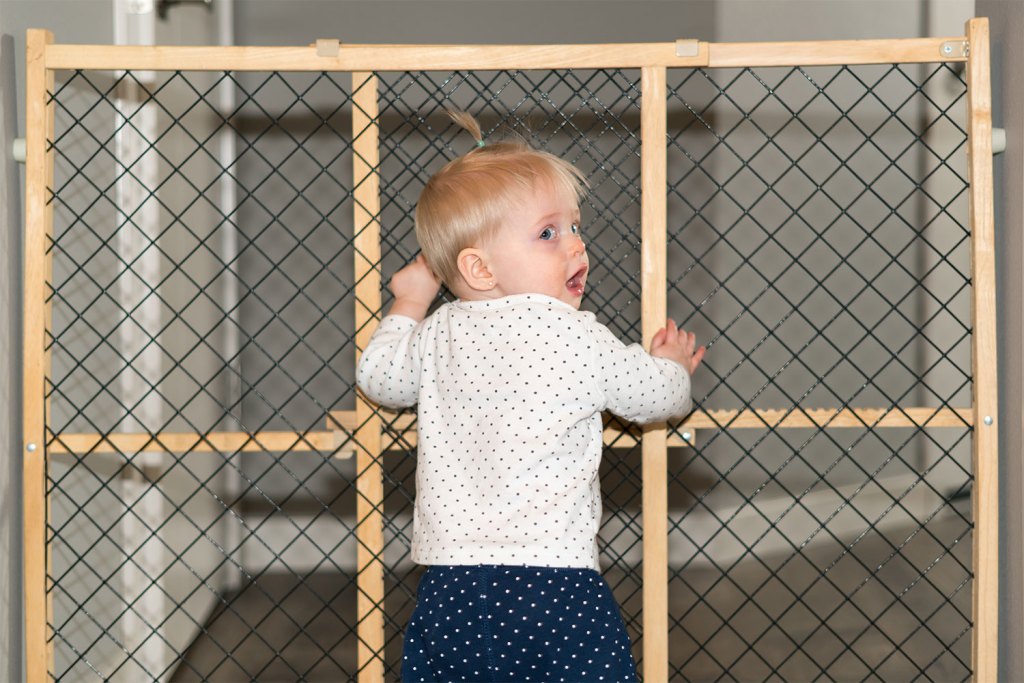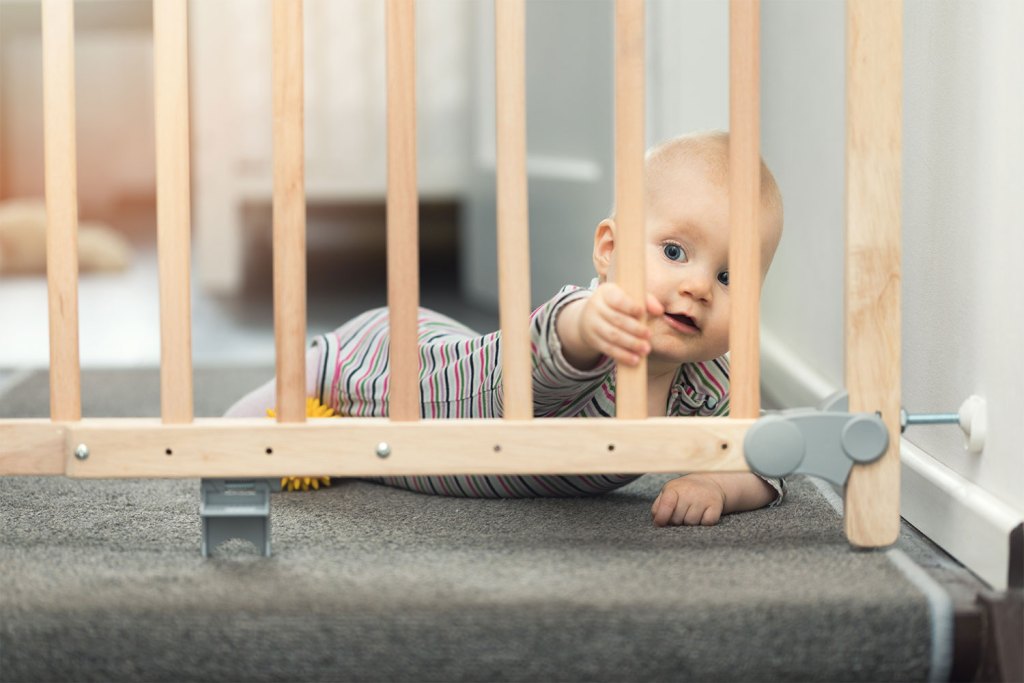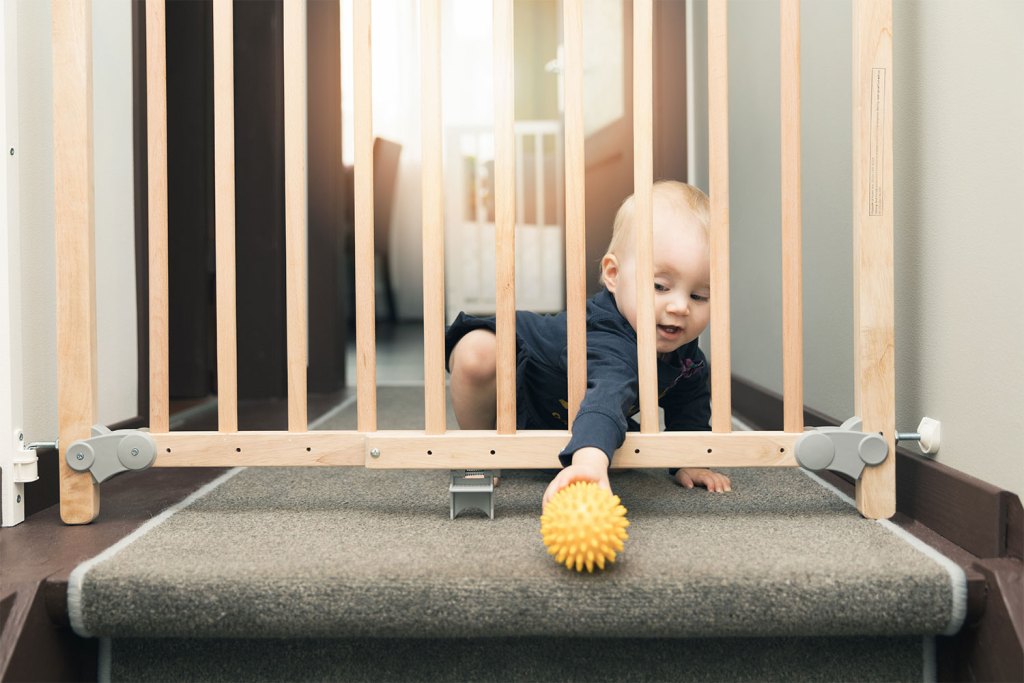Picking and purchasing baby gates are part of the process of babyproofing homes. Wood baby gates are a stylish solution to keep your baby from accessing unsafe areas of your home. They are available in a variety of colors and finishes to block stairways or kitchens, while enhancing your home decor and keeping a modern look. The concern with wooden baby gates is that, although they are meant to protect your baby, they may actually include some unsafe features that could in fact harm your little one. Let’s take a look at some of the pros and cons of these popular baby-proofing items
Pro: Sturdy and durable
Wood is a strong and long-lasting material that looks great in every home. Many parents choose wooden baby gates because they typically last throughout your child’s toddler years without damage. Many gate models are reinforced with metal for extra durability and a more secure installation.

Pro: Less expensive
Many parents choose wooden baby gates because they tend to be less expensive than safety gates made from other materials. Lower prices are especially helpful to families who live in larger homes with multiple areas that could be out of bounds for toddlers. In those cases, you’ll need to purchase several baby gates, and this could add up pretty quickly.
Pro: Good looking
Wood is an elegant and attractive material that most people prefer for their homes. Unlike metal or plastic models that are often an eyesore, wooden baby gates come in a variety of shades and designs. Many parents like them because they combine nicely with their current furniture. Some feature pretty distinctive patterns so you can incorporate them as part of your decoration, rather than trying to blend them into the background.
Pro: Portability
Most wooden baby gates are portable and lightweight. This can be a very convenient feature when you need to move the gate around your home or don’t want to install it in a single place. It can also come in handy when you travel or when your child has sleepovers at their grandparents’ home.

Con: Mounting
Certain wood gate models require mounting them to the wall or door frame. While this makes your gate even sturdier and provides peace of mind to you as a parent, the installation requires more work. Aside from the added effort of screwing and drilling, it’s important to keep in mind that your baby will eventually outgrow the gate. And when they do, your wall or door frame won’t look that great. It’ll require retouching from you or a professional.
Con: Can be pushed out
While freestanding and pressure-mounted safety gates cause no damage to your walls or door frames, the lack of hardware makes them easier to push out of place. If you have a strong toddler or if your child likes to lean into the gates, these less-stable products can be unsafe and become hard to keep in one place.
Con: Choking hazard
Accordion-style wooden baby gates have large diamond and v-shaped openings that are large enough for a baby’s head. This presents a serious choking hazard, as a child’s head could get stuck in the openings. These old-fashioned models were manufactured more than 30 years ago and have caused many gate-related injuries and deaths. Due to the high number of incidents reported, experts recommend avoiding these accordion-style baby gates, and several models have been recalled in recent years.
Con: Chipping
Though less frequent than other accidents, it is possible that your wooden baby gate could crack. If this happens, it’s possible for your child to cut themselves or for you to get splinters. If you notice that your wooden gate has cracked, it is best to sand it down whenever it is possible or replace the gate altogether, especially if this crack compromises the sturdiness and safety of the gate.

Tips for new parents
If the pros of wood baby gates outweigh the cons for you, here are some useful tips for new parents to keep in mind:
- Use the right type of gate for the right place
- Do not use pressure-mounted gates to block off staircases
- Never use freestanding gates at the tops or bottoms of stairs
- Avoid gates with plastic parts that can break off into smaller pieces and create a choking hazard to young children
- Look for models with doors that swing open, for ease of use
- When it’s possible, choose models with one-hand release or foot pedals for you to use easily while carrying baby
- Avoid climbing over gates to prevent accidents among adults or older children
- Never climb over a safety gate while carrying your child
- Use freestanding gates for homes with open floor plans
- Consider add-on sections for areas of your home that are more difficult to gate
Wood safety gates can be an excellent way to keep your child from entering parts of the home where they could be at risk. By blocking off access to certain parts of the home, you can childproof more easily and efficiently. These convenient gates make your life easier as a parent, so you can always keep an eye on your little one while doing other chores or activities. With so many models and designs to choose from, you can find one that suits your home decor and your personal needs. Just keep in mind the expert recommendations to avoid accidents and keep your family safeguarded at all times.
Editors' Recommendations
- We love these gorgeous aesthetic names for baby boys and girls
- Musical baby names that will make your heart sing
- Is Theraflu safe for breastfeeding moms? Here’s what you need to know
- The baby registry: Pros and cons of this popular practice
- Some babies want to be held while sleeping: Here’s why


